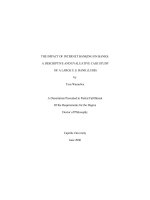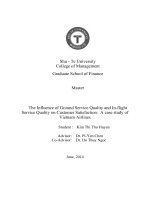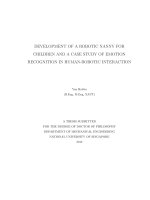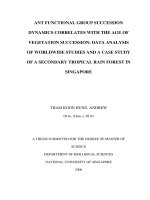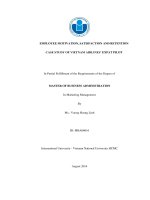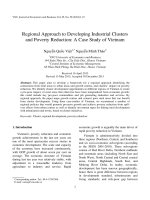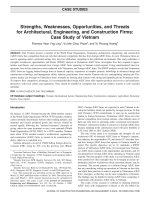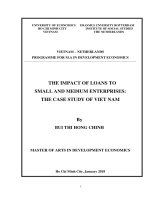Employee motivation, satisfaction and retention case study of vietnam airlines expat pilot
Bạn đang xem bản rút gọn của tài liệu. Xem và tải ngay bản đầy đủ của tài liệu tại đây (836.59 KB, 85 trang )
EMPLOYEE MOTIVATION, SATISFACTION AND RETENTION
CASE STUDY OF VIETNAM AIRLINES’ EXPAT PILOT
In Partial Fulfillment of the Requirements of the Degree of
MASTER OF BUSINESS ADMINISTRATION
In Marketing Management
By
Ms.: Vuong Hoang Linh
ID: MBA06016
International University - Vietnam National University HCMC
August 2014
EMPLOYEE MOTIVATION, SATISFACTION AND RETENTION
CASE STUDY OF VIETNAM AIRLINES’ EXPAT PILOT
In Partial Fulfillment of the Requirements of the Degree of
MASTER OF BUSINESS ADMINISTRATION
In Marketing Management
By
Ms.: Vuong Hoang Linh
ID: MBA06016
International University - Vietnam National University HCMC
August 2014
Under the guidance and approval of the committee, and approved by all its members,
this thesis has been accepted in partial fulfillment of the requirements for the degree.
Approved:
---------------------------------------------Chairperson
---------------------------------------Committee member
---------------------------------------------Committee member
---------------------------------------Committee member
---------------------------------------------Committee member
---------------------------------------Committee member
INTERNATIONAL UNIVERSITY
SCHOOL OF BUSINESS
SOCIALIST REPUBLIC OF VIETNAM
Independence - Freedom - Happiness
ASSURANCE QUALIFIED THESIS
Student’s Name:
Vuong Hoang Linh
Student ID:
MBA06016
Title of Thesis:
Employee Motivation, Satisfaction And Retention: Case
Study Of Vietnam Airlines’ Expat Pilot
Advisor:
Nguyen Quynh Mai Ph.D
I assure that the content of this thesis has been qualified all requirements for a
research paper and able to participate in the final thesis defense.
Approved by
i
Acknowledge
I would never have been able to finish this thesis without the guidance of
committee members, help from friends and interview participants, and support from
my family.
I am most grateful to my parents and brother for giving me their best support
and encouragement at all times.
I would like to express my deepest gratitude to my advisor, Dr. Nguyen
Quynh Mai for her excellent guidance and support to improve my thesis from a
beginning idea to the final research.
I would like to thank my MBA classmates for their great support throughout
the MBA journey. The special thanks come to Tuan and Trang who have dedicated
their time and support to help me finish this thesis.
I would like to thank all the pilots who have devoted their time to take part in
the interviews for my research. Without their knowledge and experiences, this thesis
would have never been fulfilled.
Finally, I would like to acknowledge the financial, academic and technical
support of the Vietnam International University. I also thank the School of Business,
all lecturers and assistant staffs for their teaching and assistance since the start of my
MBA course in 2012.
ii
Plagiarism Statements
I would like to declare that, apart from the acknowledged references, this
thesis either does not use language, ideas, or other original material from anyone; or
has not been previously submitted to any other educational and research programs or
institutions. I fully understand that any writings in this thesis contradicted to the above
statement will automatically lead to the rejection from the MBA program at the
International University – Vietnam National University Ho Chi Minh City.
iii
Copyright Statement
This copy of the thesis has been supplied on condition that anyone who
consults it is understood to recognize that its copyright rests with its author and that
no quotation from the thesis and no information derived from it may be published
without the author’s prior consent.
© Vuong Hoang Linh/MBA06016/2012-2014
iv
Table of Contents
Acknowledge ............................................................................................................................. ii
Plagiarism Statements ............................................................................................................... iii
Copyright Statement ................................................................................................................. iv
List of Tables ........................................................................................................................... vii
List of Figures ......................................................................................................................... viii
Abbreviation List ...................................................................................................................... ix
Abstract ..................................................................................................................................... xi
Chapter One - Introduction ........................................................................................................ 1
1. Company Background: ...................................................................................................... 1
2. Problem Statement: ........................................................................................................... 2
3. Research Objectives: .......................................................................................................... 3
4. Research Questions: ........................................................................................................... 3
5. Limitation and Scope of Research: .................................................................................... 4
6. Implication for the research: .............................................................................................. 4
Chapter Two - Literature Review .............................................................................................. 6
1. Employee Motivation: ....................................................................................................... 6
1.1. Maslow’s Hierarchy of Needs: ................................................................................... 6
1.2. Herzberg’s two factor theory: ..................................................................................... 7
1.3. Goal-Setting theory: .................................................................................................... 8
1.4. Expectancy Theory: .................................................................................................... 9
2. Employee Satisfaction: .................................................................................................... 10
3. Employee Loyalty: ........................................................................................................... 11
4. Human Resource Management (HRM) in Airlines: ........................................................ 12
Chapter Three - Research Methodology .................................................................................. 16
1. Research design: .............................................................................................................. 16
1.1. Setting and sample: ................................................................................................... 16
1.2. Data collection: ......................................................................................................... 17
1.2.1. Interview procedures:......................................................................................... 17
1.2.2. Interview questions: ........................................................................................... 17
2. Data analysis method: ...................................................................................................... 17
Chapter Four – Findings and Results ....................................................................................... 20
1. Factors concerning employee satisfaction and retention of Vietnam Airlines’ expat
pilots: ................................................................................................................................... 20
v
1.1. Theme 1: Job Stress .................................................................................................. 20
Sub Theme 1: Workload .............................................................................................. 21
Sub Theme 2: Flight Roster ......................................................................................... 23
Sub-theme 3: Performance pressure ............................................................................ 27
1.2. Theme 2: Perceived Organizational Support (POS) ................................................. 28
Sub-theme 1: Supervision Support .............................................................................. 28
Sub-theme 2: Employee Feedback............................................................................... 30
Sub-theme 3: Employee Assistance ............................................................................. 31
1.3. Theme 3: Salary ........................................................................................................ 34
1.4. Theme 4: Benefit package......................................................................................... 37
1.5. Theme 5: Organizational Justice ............................................................................... 40
1.6. Theme 6: Promotional Chances ................................................................................ 43
1.7. Theme 7: Alternative Job Opportunities ................................................................... 46
2. Causal model of employee retention for Vietnam Airlines’ expat pilots:........................ 48
Chapter Five – Conclusions and Recommendations................................................................ 51
1. Conclusions:..................................................................................................................... 51
2. Suggestions for Vietnam Airlines to improve employee motivation, satisfaction and
retention of expat pilots: ...................................................................................................... 52
2.1. Improve scheduling:.................................................................................................. 53
2.2. Improve HRM practices:........................................................................................... 54
2.2.1. Improve salary and rewarding system ............................................................... 54
2.2.2. Improve Benefit package ................................................................................... 55
2.2.3. Reduce performance appraisal pressure ............................................................. 56
2.2.4. Offer good Promotional Chances ....................................................................... 57
2.2.5. Improve Two-way Communication between Expat Pilots and Supervision...... 57
2.2.6. Improve paper work procedures ........................................................................ 58
2.2.7. Improve Fair Treatment ..................................................................................... 58
3. Recommendations for further research: ........................................................................... 60
References ................................................................................................................................ 61
Appendix.................................................................................................................................. 69
vi
List of Tables
Table 1: Definitions of Determinants and Intervening Variables ............................... 49
Table 2: Causal relationships of Determinants and Intervening Variables ................. 50
vii
List of Figures
Figure 1: Frequency summary on Themes concerning employee satisfaction and
retention of Vietnam Airlines’ expat pilots ................................................................ 20
Figure 2: Causal model of employee retention for Vietnam Airlines’ expat pilots .... 50
viii
Abbreviation List
Abbreviation
A
AOG
ASEAN
ATR
B
CAPT
Term
Airbus – Airline Manufacture
Aircraft on ground
Association of South-East Asian Nations
Avion de Transport Regional – Airline Manufacture
Boeing – Airline Manufacture
Captain
CAQDAS
Computer Assisted Qualitative Data Analysis Software
FO or F/O
First Officer
FOM
Flight Operation Manual
GD
General Declaration
HR
Human Resource
HRM
ID
POS
Human Resource Management
Interline Discount
Perceived Organizational Support
ix
SIA
Singapore Airlines
SOP
Standard Operation Manual
TRE
Type Rated Examiner
TRI
Type Rated Instructor
VNA
Vietnam Airlines
ZED
Zonal Employee Discount
x
Abstract
This thesis investigates Vietnam Airlines’ current issue of expat pilot leakage. By
conducting an extensive qualitative case study composed of 10 in-depth interviews
with Vietnam Airlines’ expat pilots, the author identify seven main themes that
affected on dissatisfaction and turnover of this workforce. Participants described how
HRM practices in Vietnam Airlines lead to dissatisfaction in work, and result in
turnover. In addition, they also gave recommendations to improve the working
condition for expat pilots of Vietnam Airlines. Based on prior researches and founded
themes, this study proposes a causal model of employee retention for Vietnam
Airlines’ expat pilots. This model can help Vietnam Airlines identify the key factors
that affected on expat pilot retention and how to improve the overall working
condition for expat pilots. Finally, based on successful practices of other airlines and
participant’ recommendations, the author suggests some improvements for employee
motivation, satisfaction and retention of Vietnam Airlines’ expat pilots.
Key words: Employee retention; Airline pilot; Qualitative
xi
This page is intentionally left blank
xii
Employee Motivation, Satisfaction and Retention
Case study of Vietnam Airlines’ Expat Pilots
Chapter One - Introduction
1. Company Background:
Vietnam Airlines is the national flag carrier of Vietnam. The history of Vietnam
Airlines can be dated back to January 1956, when the Government set up the Vietnam
Civil Aviation Department, beginning the civil aviation industry in Vietnam. At that
time, there were only five aircrafts of Ilyushin IL-14, Antonov AN-2, and Aero-45…
which served domestic flights during Vietnam War. In April 1993, Vietnam Airlines
was officially established as the country’s national flag carrier.
“For 20 years of development at an average annual growth rate consistently in doubledigit number, the national flag carrier has marked an obvious advance to become a
major competitor in the Asian aviation market, owning a modern fleet of Airbus and
Boeing planes flown by well trained professionals. Beginning with non-regular
domestic services, today Vietnam Airlines operates to 21 cities throughout the country
and 28 international destinations in Asia, Europe, and Australia. Its network extends
to 26 countries and territories. In June 2010, Vietnam Airlines joined SkyTeam, the
world’s second largest global airline alliance, affirming the carrier’s new position on
the global aviation map as the strategic partner of the alliance in Southeast Asia
region as well as its international standard services.” (Vietnam Airlines background,
n.d.).
Vietnam Airlines aims to become a strong brand of airline service in the ASEAN area
and the world. To achieve this long-term goal, human resource is a vital factor that the
company should focus. Because not like technology, processes or organizational
structure, competent and dedicated employees cannot be easily copied and replaced.
As the national flag carrier, it is especially true to Vietnam Airlines since their
Vuong Hoang Linh - MBA06016
Page 1
Employee Motivation, Satisfaction and Retention
Case study of Vietnam Airlines’ Expat Pilots
employees should deliver not only airline services but also image of the country.
2. Problem Statement:
Vietnam domestic airline service market has changed recent years due to several
changes of government policies. From a monopoly market with just one national
airline, the picture now has changed to be an oligopoly market with more carriers.
With the entry of low cost competitors, Vietnam Airlines now faces a lot of pressure
to compete with fare price and service offers. From long time monopoly, Vietnam
Airlines enjoy a lot of advantages from ground handling services, technical fixing,
flight routes, business experiences, and trained human resources. However, these
advantages can be overcome if the company does not have appropriate strategies to
enhance the competence.
Among domestic competitors, Vietjet Air, a new low cost airline which operating
since 2011 recently has put new challenges to Vietnam Airlines. Not only compete
with fare price and services, Vietjet Air now offer huge salaries to attract Vietnam
Airlines’ front-line staffs to work for the company. This tactic has made a lot of expat
pilots quit job at Vietnam Airlines. Vietnam Airlines now has over 800 pilots and one
third of them are expatriates. Most of these expat pilots are Captain so their roles in
flight are very important. The remaining two third of Vietnam Airlines’ flight crew
are local pilots but just one third of them are Captain. Therefore, a lot of expat pilots
quit job at Vietnam Airlines will put the company in difficult operating issues.
The company, of course, can hire new expat pilots for their upcoming high season.
However, training new recruits will take more time for the company to fill up all
shortage positions, the situation that will result in harder flight roster plans. Moreover,
other pilots who are working for the company, in turn, have to fly more time to fill up
flight plans. This working pressure can result in employee dissatisfaction and safety
Vuong Hoang Linh - MBA06016
Page 2
Employee Motivation, Satisfaction and Retention
Case study of Vietnam Airlines’ Expat Pilots
issues. Thus, Vietnam Airlines now face problems not only to hire new expat pilots
but also to satisfy current ones to keep them staying with the company.
In addition, Vietnam Airlines was privatized in 2014 to change from a state-owned
company to become a joint stock corporation. This change required Vietnam Airlines
to do business more effectively and sustainably. This also meant that the company
will have to compete fiercely with all opponents in order to survive and stay
profitably. According to Macey and Schneider (2008), employee loyalty is a dominant
source of competitive advantage and thus, has been drawn to its reported ability to
solve challenging organizational problems such as increasing workplace performance
and productivity amid widespread economic decline. From this view, we can see that
the issue of expat pilot leakage and dissatisfaction can affect badly to Vietnam
Airlines’ competitive advantage in the long run.
3. Research Objectives:
This research attempts to accomplish main objectives as below:
-
To identify problems of employee motivation, satisfaction and retention of
Vietnam Airlines’ expat pilots.
-
To evaluate HRM practices of Vietnam Airlines base on expat pilot’s
experiences.
-
To propose useful suggestions to improve employee satisfaction and retention of
Vietnam Airlines’ expat pilots.
4. Research Questions:
This research aims to provide some solutions for the following research questions:
-
Why expat pilots are not satisfied with their works at Vietnam Airlines?
-
How HRM practices of Vietnam Airlines affect on pilot satisfaction and
retention?
Vuong Hoang Linh - MBA06016
Page 3
Employee Motivation, Satisfaction and Retention
Case study of Vietnam Airlines’ Expat Pilots
-
What are the key determinants for Vietnam Airlines to improve pilot satisfaction
and retention?
5. Limitation and Scope of Research:
The research will be conducted from in-depth interview with small group of Vietnam
Airlines’ expat pilots. Because of the limitation of sample size, the study results may
not reflect broadly the whole picture of the Vietnam Airlines’ flight crew resources.
In this research, the factors affecting employee satisfaction and loyalty are studied
based on employee’s perception. Hence, the result would be subjective.
The result of this study can only be represented for the case of Vietnam Airlines only.
Thus, it may not be representative for other companies in the industry.
6. Implication for the research:
In general, the findings of this study are expected to provide the general
understanding about how expat pilots perceive Vietnam Airlines’ working
environment. More importantly, the results of the study can provide managers of
Vietnam Airlines with important information for strategic improvement of employee
retention.
From the managerial perspective, employee loyalty is an important part of human
resource management: What do employees expect from the company? Have these
expectations been met? Which gap in the human resource management need to be
improved in order to retain experienced and dedicated employees? By finding
answers for these questions, the study can propose solutions for a better working
environment.
From a corporate perspective, employee loyalty is a critical element contributes to
Vietnam Airlines’ competitive advantages. The company will take benefits from
dedicated employees through better service outcomes. Hence, study on employee
Vuong Hoang Linh - MBA06016
Page 4
Employee Motivation, Satisfaction and Retention
Case study of Vietnam Airlines’ Expat Pilots
loyalty can also help improving service performance of Vietnam Airlines.
Last but not least, the study should make contributions to employee loyalty theory by
exploring a specific case of Vietnam Airlines. Thus, the results of this research can be
considered for further researches.
Vuong Hoang Linh - MBA06016
Page 5
Employee Motivation, Satisfaction and Retention
Case study of Vietnam Airlines’ Expat Pilots
Chapter Two - Literature Review
1. Employee Motivation:
Motivation is one of the most commonly topics in Organizational Behavior researches
(Latham & Pinder, 2005). Motivation can be defined as “a person’s active
participation and commitment to achieve the prescribed results” (Halepota, 2005).
According to Pinder (2008), it is the progression that explains an individual’s
intensity, direction, and persistence of effort toward achieving a goal. “Intensity”
explains how hard a person tries to achieve his/her goals. However, high intensity
does not mean it can lead to favorable job-performance results unless the effort is
guided in a “direction” that profits the organization. Lastly, “persistence” measures
how long a person can keep effort to achieve the goal (Pinder, 2008).
There are a lot of theories involving employee motivation. From 1950s, we can point
out two best known theories: Abraham Maslow’s Hierarchy of Needs and Herzberg’s
two factor (motivation-hygiene) theory.
1.1. Maslow’s Hierarchy of Needs:
Maslow (1943) assumed that human needs can be ranked into five categories:
physiological, safety, social, esteem and self-actualization. He divided the five needs
into higher and lower levels. According to this theory, physiological needs (hunger,
thirst, shelter, sex) and safety needs (secure from physical and emotional harm) are
lower-order needs that motivate every people. On the higher level, people are
motivated by social (affection, belongingness, friendship), esteem (self-respect,
autonomy, achievement) and self-actualization (growth, achieving potential, selffulfillment) needs. When lower-order needs are satisfied, employee is no longer
motivated by these factors and moves “up” the hierarchy to seek for higher-order
Vuong Hoang Linh - MBA06016
Page 6
Employee Motivation, Satisfaction and Retention
Case study of Vietnam Airlines’ Expat Pilots
needs. Thus, a manager should understand what level of hierarchy that his/her
employees are currently on and focus on satisfying needs at or above that level.
Although Maslow’s theory has received wide attention, especially among practicing
managers, researchers does not validate it due to lack of empirical evidence. There is
little substantiation that human needs follow Maslow’s model, that unsatisfied needs
motivate people, or that a satisfied need initiates movement to a new need level.
1.2. Herzberg’s two factor theory:
Herzberg (1959) believes that intrinsic factors such as advancement, recognition,
responsibility and achievement impact job satisfaction. Employees who feel good
about their work seem advance these factors. On the other hand, dissatisfied
employees tend to blame extrinsic factors such as supervision, pay, company policies
and working conditions as work motivation.
According to Herzberg, opposite of satisfaction is not dissatisfaction as was
traditionally thought. To him, the opposite of “satisfaction” is “no satisfaction” and
the opposite of “dissatisfaction” is “no dissatisfaction”. It means that satisfaction and
dissatisfaction cannot be reliably measured on the same continuum.
Herzberg characterized factors such as quality of supervision, salary, company
policies, physical working conditions, colleague relationships and job security as
hygiene factors. When these factors are acceptable, employees will not be dissatisfied;
neither will they be satisfied. Thus, if managers want to motivate workers on their
jobs, they should focus on factors associated with the job itself or with results derived
directly from it. These motivational factors are promotional opportunities, personal
growth opportunities, recognition, responsibility, and achievement (Herzberg et al.,
1959).
The two-factor theory, however, has not been well validated in the literature due to
Vuong Hoang Linh - MBA06016
Page 7
Employee Motivation, Satisfaction and Retention
Case study of Vietnam Airlines’ Expat Pilots
many criticisms. They are: (1) the theory appeared to be limited in methodology due
to research on self-report; (2) the theory confused factors causing feelings of
satisfaction and dissatisfaction with the causes that made the event happen; (3) the
reliability of the data could have been negatively determined by ego-defensiveness of
employee; (4) factors confused as sources of satisfaction and dissatisfaction; (5) the
value of the factors differed as a function of the occupational level; and (6) the theory
ignored the fact of individual differences among employees (Gaziel, 1986).
Maslow’s Hierarchy of Needs and Herzberg’s two factor theory are early theories of
motivation. Going further, researchers have explored new theories of employee
motivation. Unlike early theories that lack of empirical evidence, these new theories
have acceptable degree of validate documents in explaining employee motivation. In
the context of this research, the literature will focus on Goal-Setting theory and
Expectancy Theory.
1.3. Goal-Setting theory:
Edwin Locke (1968) proposed that goal setting is a major source of work motivation.
Specific goals tell an employee what need to be done and how much effort is needed
(Earley et al., 1987). According to this theory, difficult goals, if accepted, result in
higher work performance than do easy goals; and that feedback from work progress
leads to higher goal performance than does no feedback.
Locke (1968) believes that challenging goals motivate employee by: (1) get employee
attention and therefore help them to focus; (2) energize employee to work harder to
attain them; (3) get employee persisted in trying to achieve them; (4) lead employee to
discover more effective strategies in doing job or task.
Furthermore, sending feedback on goal performance is necessary. It helps employees
to identify inconsistencies between what they have done and what they plan to do.
Vuong Hoang Linh - MBA06016
Page 8
Employee Motivation, Satisfaction and Retention
Case study of Vietnam Airlines’ Expat Pilots
That is feedback guides employee behavior (Locke, 1996).
In addition to sending feedback, there are three other factors that affect the goalsperformance outcome: goal commitment, task characteristics and national culture.
Goal commitment requires employees to be committed to the goal and determined not
to lower or abandon it (Hollenbeck et al., 1989). Task characteristics affect
performance more strongly when tasks are simpler rather than complicated, welllearned rather than new, and independent rather than dependent (Locke et al., 1987).
Finally, setting goals should consider national culture differences. In collectivistic and
high-power-distance cultures, people prefer moderate goals than difficult ones
(Gilman & Marginson, 2002; Addison & Belfield, 2002; Keller, 2002).
1.4. Expectancy Theory:
One of the most popular explanations of employee motivation is Victor Vroom’s
expectancy theory. Vroom (1964) argued that employees will put more effort in work
when they believe that it will lead to a good performance consideration; then the good
consideration will lead to organizational rewards such as bonuses, pay increases, or
job promotions; that when the rewards will satisfy employee’s personal goals.
According to this theory, motivation = expectancy * instrumentality * valence.
Expectancy refers to different expectations and confidence levels of employees in
work. Managers have to discover what resources, training or supervision that
fulfills employee’s need.
Instrumentality refers to the employee’s perception of whether they will actually
get what they desire even if it has been promised by their manager. Managers
must ensure that promises of rewards are fulfilled and all employees are aware of
that.
Valence refers to the emotional orientations employee hold with respect to
Vuong Hoang Linh - MBA06016
Page 9
Employee Motivation, Satisfaction and Retention
Case study of Vietnam Airlines’ Expat Pilots
outcomes (rewards). The depth of the want of an employee for extrinsic (money,
promotion, time-off, benefits) or intrinsic (satisfaction) rewards. Managers must
discover what employee value in order to give adequate rewards.
Expectancy theory works well when organization actually rewarded employees for
performance rather than seniority, loyalty, skill level, and job difficulty. Otherwise,
this theory will not have sufficient impacts on employee motivation.
From all motivation theories mentioned above, this study considers using Herzberg’s
two factor theory as the primary approach to evaluate employee satisfaction.
2. Employee Satisfaction:
For years, employee job satisfaction has been a favorite topic among industrial and
organizational psychology researchers. Employee satisfaction can be defined as “a
favorable attitude or pleasurable emotional state that results from a person’s job
experience or a fit between a person and an organization” (Ugboro & Obeng, 2000;
Reilly, Chatman & Caldwell, 1991).
According to Hagedorn (2000), employee satisfaction is enhanced when he/she feels a
high level of achievement, is intensely involved in his/her job, and is appropriately
rewarded by recognition, responsibility, and salary. Furthermore, the researcher
pointed out how job satisfaction forecasts employee engagement. Hagedorn (2000)
argued that employee who is experiencing a high level of job satisfaction would be
likely to value his/her position and be proud of the organization, resulting in high
probability of job engagement. In contrast, due to very low level of satisfaction,
disengaged employee is not excited to contribute to the benefits of the organization,
therefore is not actively engaged in work (Hagedorn, 2000). In this relation, a lot of
studies argue that job dissatisfaction is a dependable predictor of burnout and turnover
(Laschinger et al., 2006; Hellman, 1997; Harter et al., 2002).
Vuong Hoang Linh - MBA06016
Page 10
Employee Motivation, Satisfaction and Retention
Case study of Vietnam Airlines’ Expat Pilots
It is also generally held that employee empowerment results in higher level of job
satisfaction, primarily because of employee involvement in goal setting and in
decision making (Blackburn & Rosen, 1993; Ugboro & Obeng, 2000; Laschinger et
al., 2006). In addition, it is proved that job satisfaction results in higher level of
employee
commitment.
Employee
commitment,
in
turn,
creates
valuable
organizational citizenship behavior - the willingness of employee to engage in extra
role behavior that is not generally noted as part of job description (Williams &
Anderson, 1991). Thus, the authors argued that empowerment positively affects
employee satisfaction and that employee satisfaction can also enhance level of
employee engagement.
3. Employee Loyalty:
According to Bidwell (2011), the term “loyalty” can be divided into two parts: “The
first part is having the employer's best interests at heart. The second part is when an
employee remains with the same employer rather than moving on.” Employee loyalty
is an organizational citizenship behavior that reflects dedication to the organization
through the promotion of its interests and image to outsiders. Employees who engage
in these loyalty behaviors act as supports for the organization’s products, services and
image to consumers (Bettencourt, Gwinner, & Meuter, 2001).
Walker (2001) considered managing loyalty of promising employees is the vital mean
of achieving competitive advantage amongst organizations. Previous studies proposed
several factors that can affect employee retention. The factors are: career
opportunities,
work-life
balance,
work
environment,
organizational
justice,
resignation policy and organization image (Cappelli, 2000).
More than that, Glen (2006) identified nine predictors of employee retention:
organizational processes, role challenges, values, work-life balance, information,
Vuong Hoang Linh - MBA06016
Page 11
